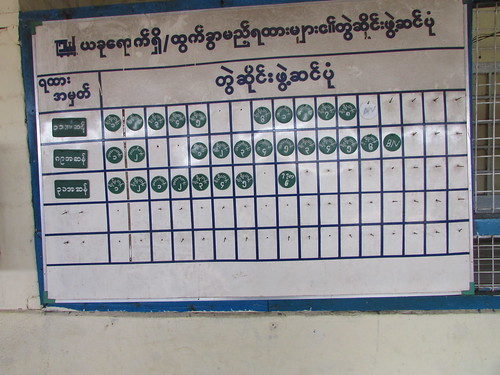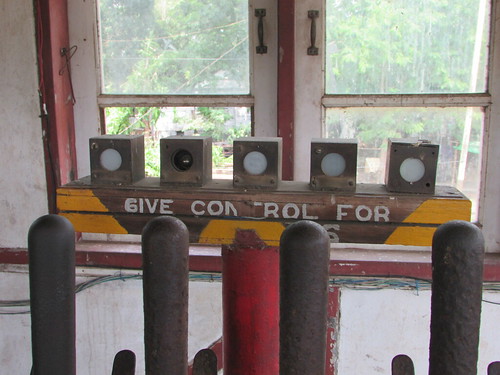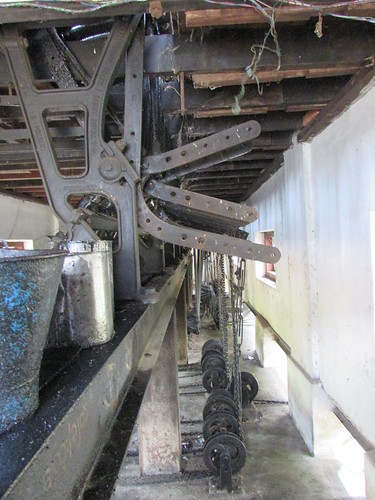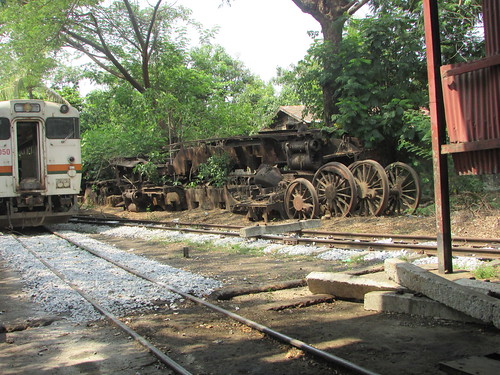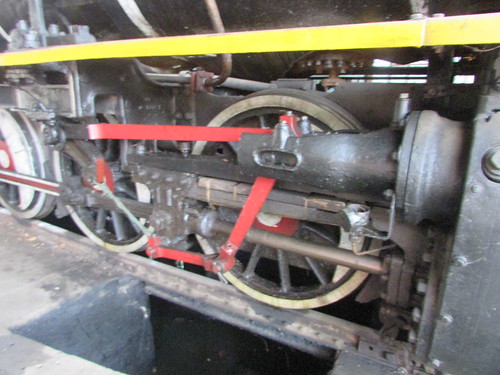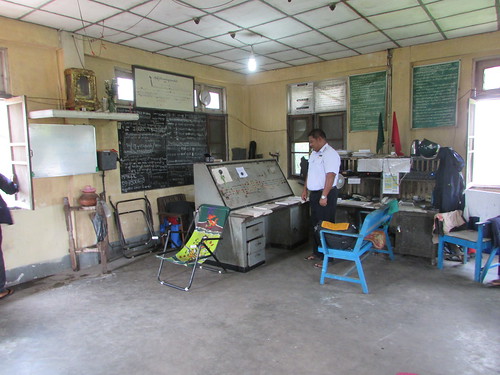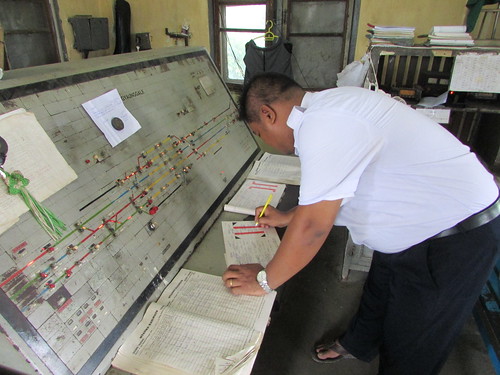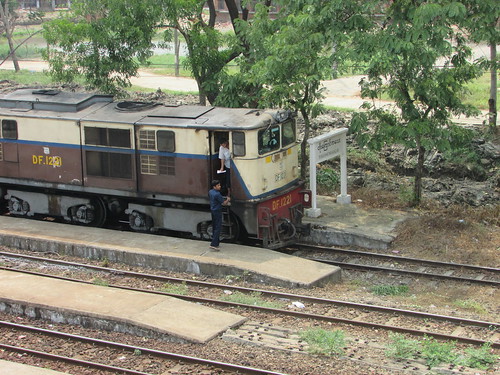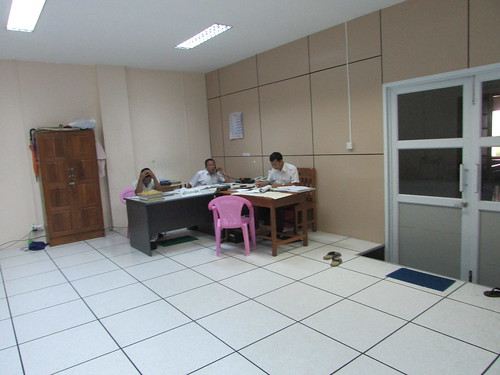During the second of two trips I made to Myanmar in 2017 (you can find all the posts on that trip here), my friend arranged a visit to the Carriage and Wagon Workshops in Myitnge, near Mandalay. My pictures taken during the visit are here.
The British-designed Carriage and Wagon Workshops at Myitnge opened in 1905. New passenger carriage building started in 1947 and, when I visited in 2017, new carriages of well-established design were still under construction although the main activity of this area, now designated Shop No. 2, was heavy repairs.
In the past, travellers on Myanma Railways could experience some fairly uncomfortable riding at times, due to a combination of poor track maintenance and vehicle suspension and draftgear. Major works on permanent way improvement (including the introduction of Continuous Welded Rails) and the introduction of Chinese-built coaches with air bag suspension were put in hand.

Myitnge Carriage & Wagon Workshops with Shop No. 2 near the centre and Shop No. 3 (with blue roof) under construction just visible at the top (Image: Google Maps)
Click for larger image
Shop No. 2
The shop comprises a number of parallel bays, aligned more-or-less north-south, each provided with an overhead travelling crane and a number of inset sidings allowing complete coaches to be worked on.
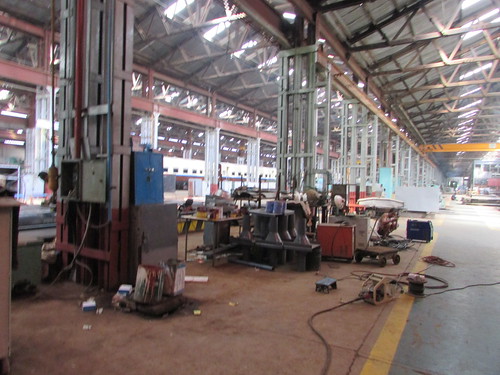
Myitnge Carriage and Wagon Workshop: General view of Shop No. 2

Myitnge Carriage and Wagon Workshop: Shop No. 2 showing completed carriages (l), carriage sub-assembly jigs with welding in progress (r)

Myitnge Carriage and Wagon Workshop: Assembling new carriage side panel in Shop No. 2

Myitnge Carriage and Wagon Workshop: 'Mini-Ostrich' gas profile cutting machine in No. 2 Shop

Kanto Yuatsu Power Press in No. 2 Shop
Myitnge Carriage and Wagon Workshop: Production plan for two types of new-build existing-design coach - 30 off BDTEZ and 10 off BDUEZ in 2017-2018
Outside the north end of Shop No. 2, an impressive electric traverser carried on six parallel rails is provided to transfer complete coaches between the various sidings.

Myitnge Carriage and Wagon Workshop: Coach Traverser with Bogie Shop in background
To the north of the traverser the separate, more recently built, Bogie Shop produces various types of bogies used on Myanma Railways.

Myitnge Carriage and Wagon Workshop: Assembly jig used during Bogie Frame construction in Bogie Shop
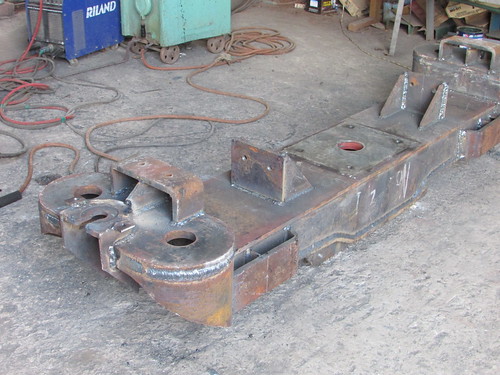
Myitnge Carriage and Wagon Workshop: Bogie sub-assembly fabrication

Myitnge Carriage and Wagon Workshop: TKZ8 Bogie Frame assembly Plano Miller in Bogie Shop
I was impressed by the quality of workmanship and the results achieved by these generally rather elderly workshops. But an ambitious project to build a new facility for the production of the Chinese coach design in Myanmar was well underway and, during my 2017 visit, I was able to tour the construction site which lies to the north of the traverser mentioned above.
Shop No. 3 under construction
The impressive high-bay building was largely complete and fitting-out was in progress. It comprises multiple bays, aligned north-south, each provided with a number of Hena Sinoko Chinese-built overhead travelling cranes. In the unfinished storage area outside the building there was also a large Chinese portal crane.

 Myitnge Carriage and Wagon Workshop: Shop No. 3 for producing coaches with air-suspension.
Myitnge Carriage and Wagon Workshop: Shop No. 3 for producing coaches with air-suspension.
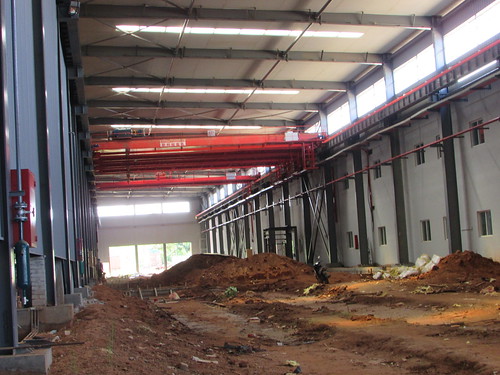
Myitnge Carriage and Wagon Workshop: Shop No. 3 under construction
Work was in progress to complete the massive concrete foundations for heavy machinery and lay the various sidings. The rest of the floor area was being prepared for the final finish of concrete. At least one excavator and a couple of roller/compactors were inside the building. A conventional diesel roller type 3Y12/15A (made by the China state-owned company XCMG) was parked but the LuiGong 'sheepsfoot' diesel compactor rumbled up and down throughout my visit, imprinting the soil with its characteristic pattern. A layer of crushed stone was being laid on top of the soil before being rolled ready to receive concrete. As is usual in Myanmar, most of the work carrying and laying stone was being carried out by women, using woven baskets to carry stone upon their head.


Myitnge Carriage and Wagon Workshop: Gang laying stone foundation in Shop No. 3
The Chinese coaches
I saw one of the imported Chinese carriages, lifted off its bogies, during my visit to the works in 2017.

Myitnge Carriage and Wagon Workshop: Modern Chinese coach bogie with air bag suspension units
Later in that trip, I saw a couple of trains that use these coaches on the Yangon - Mandalay services.

The afternoon express from Mandalay to Yangon formed from modern, Chinese-built 'air-bag suspension' coaches passes Myo Haung Signal Cabin

Mahlwagon Main Line seen from the north end of the Up Yard showing Train Number 5 Up (the 15:00 hours Yangon-Mandalay, due to arrive 05:00 the following day) with a Chinese-built Bo-Bo-Bo on a rake of Chinese-built 'air-bag suspension' coaches.
Factory opening
I understand that Shop No. 3 started manufacture in 2018 with an initial build of 15 coaches of Chinese design in Shop No. 3. More recently, Shop No. 2 has been involved in the construction of a batch of 80 coaches of Korean design. However, the Covid-19 Pandemic has prevented visits in 2020 and 2021. Following elections at the end of 2020, on February 1st 2021 the election result was repudiated by the Myanmar army who seized power alleging voter corruption so the current situation is unclear.
Revised version
It's a large works and I had initially misunderstood the numbering of the three shops but, guided by my friend who organised the tour in 2017, I've tried to correct this.

Myitnge Carriage and Wagon Works showing older Shop 1 (lower view), Shop 2 and modern Shop 3 (upper view)
MR: Myitnge Carriage and Wagon Workshop
Passenger Rolling Stock in Myanmar
[Shop numbering corrected: 11/05/2022]
